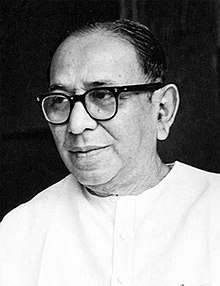Jhinabhai Desai
Jhinabhai Ratanji Desai (16 April 1903 – 6 January 1991), better known by his pen name Snehrashmi, was a Gujarati language author and Indian independence activist.
Jhinabhai Desai | |
|---|---|
 | |
| Born | Jhinabhai Ratanji Desai 16 April 1903 Chikhli, Gujarat |
| Died | 6 January 1991 (aged 87) |
| Pen name | Snehrashmi |
| Language | Gujarati |
| Nationality | Indian |
| Citizenship | India |
Life
Jhinabhai was born on 16 April 1903 at Chikhli, Gujarat. He left studies of matriculation and joined Non-cooperation movement in 1920. He joined Gujarat Vidyapith in 1921 and graduated in political science from it in 1926. He taught history and political science at Gujarat Vidyapith from 1926 to 1928. He was jailed from 1932 to 1933 for his involvement in Indian independence activities. He joined Rashtriya Shala in 1934 as the principal. He joined Sheth Chimanlal Nagindas Vidyalaya as the principal in 1938 and later served as its director.[1] He served as the acting Vice Chancellor of Gujarat University thrice. He presided Gujarati Sahitya Parishad at Madras in 1972.[2] He also served as a senate and syndicate member in different universities of Gujarat. He also served as a member of the Sahitya Akademi and Historical Records Commission.
He was the president of Surat City Congress.[3][4] He died on 6 January 1991.[5]
Works
His initial works were influenced by nationalist sentiments and Gandhian ideals as he participated in Indian independence movement.[6][7] His later works are more focused on the beauty and emotions. He chiefly wrote poetry and short stories but also ventured into other forms of literature.[2]
Poetry
His poetry collections Ardhya (1935) and Panghat (1948) including Bar Majoor nu Geet (The Song of Twelve Peasants) are the examples of his Gandhian influence.[8] His other poetry collections are Atitni Pankhmathi (1974), Kshitije Tya Lambavyo Hath (1984), Nijleela (1984).[2][9]
He introduced haiku, Japanese short form of poetry, in Gujarati literature and popularized it.[2][9][10][11] Soneri Chand Rooperi Suraj (1967) is the collection of 359 haiku and six tanka poems.[12][13] Kevalveej (1984) and Sunrise on the Snowpeaks are his other haiku collections.[2]
Tarapo (1980) and Ujani are collections of children's poetry. Sakal Kavita is the collection of his all poems published between 1921 and 1984.[2]
Short story
Gata Aasopalav (1934) was his first short story collection.[14] Tutela Taar (1934), Swarg ane Prithvi (1935), Moti Bahen (1955), Heera na Latkaniya (1962), Shrifal (1969), Kala Topi (1962) and Snehrashmi ni Shreshth Vartao (1983) are his other stort story collections.[2][9]
Autobiography
His autobiography starts from 1920. His childhood to his school education is described in Mari Duniya (1970). It is followed by Safalyatanu (1983) which has detailed account of the Non-cooperation movement and its leaders. It ends in 1933.[15] It is followed by two more volumes, Ughade Navi Kshitijo (1987) and Divas Ugyo Ane.[2]
Others
Antarpat (1961) is novel about social and cultural dimensions. Matodu ne Tulsi (1983) is his play collection. Bharat na Ghadvaiya (1957) is biography collection. Pratisad (1984) is his book on criticism. Kavya Sangraha with Umashankar Joshi (1937), Sahitya Pallav (1941) and Sahitya Pathavali (1966) are his compilations.[2][9]
Awards
He was awarded Presidents Award as the best teacher in 1961. He received Ranjitram Suvarna Chandrak in 1967 and Narmad Suvarna Chandrak in 1979.[2] In 1987, he received Sahitya Gaurav Puraskar.
References
- India Who's who. INFA Publications. 1972. p. 193.
- "દેસાઈ ઝીણાભાઈ રતનજી, 'સ્નેહરશ્મિ' (Desai Jhinabhai Ratanji, 'Snehrashmi')". Gujarati Sahitya Parishad (in Gujarati). Retrieved 9 September 2014.
- Acyuta Yājñika; Suchitra Sheth (2005). The Shaping of Modern Gujarat: Plurality, Hindutva, and Beyond. Penguin Books India. pp. 214–215. ISBN 978-0-14-400038-8.
- Hakūmatarāya Desāī; Kiraṇa Desāī (1997). The Pardi Annakhed Satyagraha: Adivasi Assertion for Rights. Centre for Social Studies. p. 46.
- "દેસાઈ ઝીણાભાઈ રતનજી, 'સ્નેહરશ્મિ' (Desai Jhinabhai Ratanji, 'Snehrashmi')". Gujarati Sahitya Parishad (in Gujarati). Retrieved 9 September 2014.
- Kartar Singh Duggal (1988). Writer in freedom struggle, India & Bulgaria. Twenty-first Century India Society. pp. 67–72.
- Yogendra K. Malik (1981). South Asian intellectuals and social change: a study of the role of vernacular-speaking intelligentsia. Heritage. p. 194.
- Sita Ram Sharma (1992). Gujarati. Anmol Publications. pp. 83–87. ISBN 978-81-7041-545-9.
- Nalini Natarajan; Emmanuel Sampath Nelson (1 January 1996). Handbook of Twentieth-century Literatures of India. Greenwood Publishing Group. p. 115. ISBN 978-0-313-28778-7.
- Kuśa Satyendra (1 January 2000). Dictionary of Hindu Literature. Sarup & Sons. pp. 15–. ISBN 978-81-7625-159-4.
- Japan Review: Bulletin of the International Research Center for Japanese Studies. International Research Center for Japanese Studies. 1992. p. 19.
- East Asian Literatures: Japanese, Chinese and Korean : an Interface with India. Northern Book Centre. 1 January 2006. p. 268. ISBN 978-81-7211-205-9.
- Indian Writing Today. Nirmala Sadanand Publishers. 1967. p. 27.
- Sisir Kumar Das (1 January 1995). History of Indian Literature: 1911-1956, struggle for freedom : triumph and tragedy. Sahitya Akademi. p. 671. ISBN 978-81-7201-798-9.
- Indian Literature. Sähitya Akademi. 1984. p. 37.